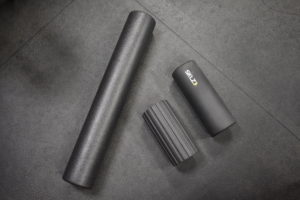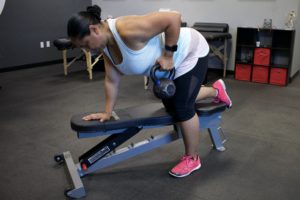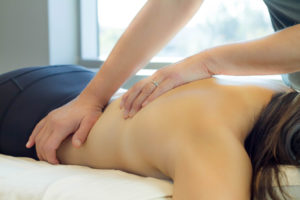
Hips can sometimes get painful. Unfortunately, painful hips and exercise don’t mix very well since most exercise involves some degree of hip movement. Whether you’ve had pain for a few years or a few weeks, the following tips can make a huge difference in your hip pain.
1. Learn to hinge from your hips
Many people with hip pain are unable to successfully hinge from their hips when lifting weight. They tend to load their knees or back t instead of their hips and often have pain at the front of the hip. If this is you, learn to do a proper hip hinge using a PVC pipe. If two legs on the ground is painful, try working on your single leg hinge.
2. Use your hamstrings
Hamstrings are supposed to help you control your hip flexion when you are bending forward. If you’re like most of the population, your hamstrings are most likely weak relative to your quads. When your hamstrings aren’t strong enough to control your hip flexion, you can get a pinchy feeling in the front of your hip. A good way to work on hamstring strength is a good morning exercise and either a seated or belly down hamstring curl.
3. Grow your glutes
Similar to hamstrings, glutes also help to control hip flexion. Your glutes additionally stabilize your hips and trunk in single limb activities such as walking, running, and lunging. As a bonus, they’re also aesthetically pleasing muscles. Regardless of where your hip pain is stemming from, glute strengthening can help you optimize your movement patterns and decrease excess stress through your irritable joint. Glutes can be strengthened in a variety of ways including hip thrusts, banded work, glute-ham raises, and lunges.
4. Track your symptom response to exercise
Often, it’s helpful to know how your body responds to different exercises so that you can figure out whether your pain is movement specific, or volume specific– that is, is it only running that flares you up, but squatting/lunging/walking are fine…or does your hip only bother you on longer runs, but is okay for shorter runs. Logging your workouts and symptoms can give you better insight into why your hips are hurting, and gives you some ideas for what exercises you still CAN do while you’re waiting for your hip calm down.
5. Track your symptom response to mobility work
Many people with hip pain find temporary relief with mobility work. Whether it’s soft tissue work with a physical therapist or massage therapist, or self mobility work using a foam roller, bands, or mobility balls, spending some time on mobility prior to exercise can help your hip feel stronger and more mobile during your workouts. Try out one of these options at a time, and track how your hip feels in the few hours afterward, or during your workout. You can also try mobilizing your upper/lower quads and glutes to see how your symptoms change.
6. Find a way to strengthen around problematic movements
If you’re dealing with hip pain, you worst decision would be to stop exercising entirely. Often, painful hips want “relative rest” for some of tissues that are stressed, but fully sedentary rest can exacerbate the situation. Movement keeps your joints lubricated and keeps blood flowing to your muscles, which they need to feel their best. Unfortunately, complete rest can result in discomfort and loss of strength/muscle mass in unused muscles over time. A modified strengthening program will allow you to build strength in your hip muscles while you allow your hip to desensitize from painful movements. Modifying can include altering your sets/rep schemes, shifting to single leg variations of movements, using tempo work, substituting movements, decreasing your range of motion, and many other options.
7. Reintegrate problematic movements without entering the pain cave ROM
Once you feel that your symptoms have calmed down, go back to your list of movements that were previously painful. For example, if full depth squats were painful on your hip, and now your hip is feeling better, choose a squat to work on. Start with a half depth squat and train it with a challenging weight. Give yourself at least 1 day to recover. As you become more confident, move into a 75% squat, and when that becomes easy, try your full depth squat. Most of your reps should be at a depth that is slightly uncomfortable for that day, but not painful. You’ll use this method to slowly reintegrate your previously painful movements. If you get any flare ups, simply repeat
8. Fix the easy things: sleep, nutrition, recovery, sedentary postures
One of the easiest ways to address pain is to adjust your lifestyle so that you are facilitating the recovery process and giving your hip an optimal environment in which to heal. Eight to nine hours of sleep is essential for muscles, tendons, bones, and joints to grow stronger, while protein is a crucial building block of these structures. The rest of your nutrition should also be in line with your goals of healing and rebuilding muscle, and this means making sure you’re taking in enough calories as well as enough micronutrients (often found in fruits and vegetables, meats, and nuts).
You can further speed your healing by paying attention to your body and allowing for full rest at least 1-2 days per week. If you’re finding that your hips are only flaring up with high volume activities (high rep squats, long distance running), see how your body feels after incorporating a deload week.
Your last easy fix is to decrease the amount of time you’re spending in sedentary postures. In an ideal world, you’re able to get up and walk every 30 minutes. But even if you have to sit all day, change the way that you’re sitting every 15 minutes (e.g. lean to the left instead of the right) so that your hips get some relief and new muscles take over some of the work.
As always, we hope this helps! If you have any questions or if you would like to read about certain topics, feel free to send us an email at TeamSP@SportsPerformancePT.com.
-Dr. Marissa Rescott, PT, DPT, CF-L1

STAY CONNECTED
Instagram: CLICK HERE
Facebook: CLICK HERE
YouTube: CLICK HERE
Podcast: CLICK HERE
TUNE IN TO OUR PODCAST












